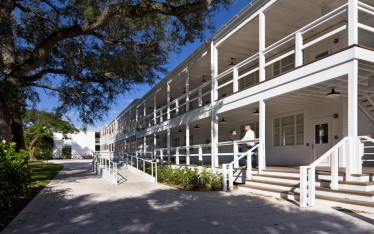UM News

Once the center of campus, 1300 Campo Sano now houses the Departments of Geography and Regional Studies, International Studies, and Political Science.
CORAL GABLES, Fla. (August 21, 2014)—Once boarded up and riddled with leaks, mold, rot, and termite damage, the wooden building that served as the University’s first registration and administration center has won three major preservation awards that honor UM’s restoration of the structure’s 1947 appearance while modernizing it for 21st century use.
Known by its 1300 Campo Sano address, the two-story building long occupied by the College of Arts and Sciences has received the American Institute of Architects Florida/Caribbean Chapter’s Honor Award of Excellence for Historic Preservation, the Florida Trust for Historic Preservation’s Outstanding Achievement Award for Restoration/Rehabilitation, and the Dade Heritage Trust’s Outstanding Restoration of a Historic Site Award.
“The building was the front door of campus, the beginning of the beginning of the modern university its founders dreamed it would be,” said noted historian and preservationist Arva Parks McCabe, a senior member of the UM Board of Trustees who wrote a book about Coral Gables and UM founder George Merrick.
Like the University’s own history, the destiny of the building that was home to the Department of Art and Art History for half a century was inextricably tied to the end of World War II, when millions of veterans seized the opportunity to attend college on the 1944 Servicemen’s Adjustment Act, or GI Bill. Almost overnight, the enrollment at UM, which was still in a temporary location on LeJeune Road to the north, nearly tripled to 5,800.
“It was an optimistic time in history,” Parks McCabe said. “We had won the war and all the GIs came back, and that is why the University of Miami became what it is.”
The heady times, though, created a quandary for UM’s first president, Bowman Ashe: How would UM accommodate the students who would flood the permanent campus?
Enter the U.S. Army, which donated the temporary wooden structures it had quickly erected for the war to universities. When the surplus buildings arrived on the UM campus by rail and in pieces, Ashe turned to South Florida architects Robert Law Weed and Marion Manley—the first woman architect in Miami and a pioneer in her field—to redesign them for the “avant-garde, international-style” they envisioned for Merrick’s “great university for a great city.”
“They integrated modernist elements: repeated large windows, a wide breezeway joining the building, and a very graphic design,” said Janet Gavarrete, associate vice president for campus planning.
The Office of the President, director of admission, and dean of the Graduate School would settle into the breezy, new space at 1300 Campo Sano, and every student would pass through it. By the late 1950s, administrators had moved on, and the art department moved in, turning the building into a hub of creativity for student artists—until 2000, when the aging structure was closed for safety.
About a decade later, the City of Coral Gables cited 1300 Campo Sano for historic preservation, and the University hired alumnus R.J. Heisenbottle, B.Arch. ’84, one of Miami’s best-known preservation architects—to preserve the building’s architecture but bring it up to modern codes and standards. It was a mammoth undertaking.
Extensive roof leaks had destroyed all of the interior finishes, and mold covered most surfaces. Termite damage and wood rot had left the structure so fragile that it had to be supported by metal braces. The mechanical, electrical, plumbing, and life safety systems no longer worked.
The contracting team from Turnkey Construction installed new impact-resistant windows and doors that matched the original ones, utilized salvaged wood for the flooring, and stripped and reinstalled the original siding. They also integrated new air-conditioning technology to minimize ductwork and allow individual temperature control in each room.
The results are remarkable. Today, 1300 Campo Sano is a peaceful yet dynamic, light-filled oasis for the Departments of Geography and Regional Studies, International Studies, and Political Science—and the winner of three awards for historic preservation.








